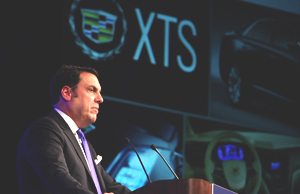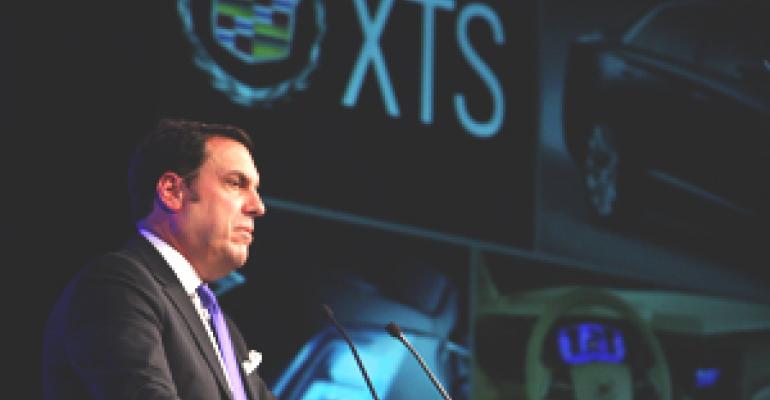
General Motors continues its remarkable turnaround from the brink of insolvency, defying skeptics with the likelihood of an eighth straight quarterly profit at year’s end and boasting a product pipeline more fully loaded and sharply focused than experts would have imagined two years ago.
The auto maker’s North American operations take a major chunk of the credit for driving GM’s bounce-back from its 2009 U.S. bankruptcy, with sales in its home market through October 14.5% ahead of year-ago, against the industry’s 10%.
Credit goes to a steady stream of new products, such as the Buick LaCrosse and Chevrolet Cruze passenger cars, as well as the surprising longevity of older models that include large cross/utility vehicles, pickup trucks and SUVs.
The revolutionary Chevy Volt extended-range electric vehicle posted its best sales month in October, and as expected, has a more diverse group of people shopping the brand’s products than ever before.
GM’s U.S. dealers also deserve credit. A majority of store owners have bought into the auto maker’s plan for the future, with its sounder and simpler go-to-market strategy, by investing millions to modernize their facilities.
However, the company’s future hardly can be considered secure.
GM continues to face tough competition from old foes such as Toyota and Honda, which after rebuilding from the earthquake crisis in their home country will be primed to aggressively seek lost market share next year.
GM’s stock, which returned to public trading amid much ballyhoo, has lost a third of its value and fueled doubts the U.S. government will exit the auto maker anytime soon, leaving it labeled “Government Motors” by many disgruntled Americans.

The U.S. economy also remains uncertain, with Europe’s debt crisis creating nervousness on Wall Street and a slow recovery on Main Street. Fuel prices continue their seesaw behavior, complicating production plans.
Such is the environment for GM North America President Mark Reuss. A lifelong GM employee with a mechanical engineering background, the 48-year-old industry veteran was brought back from an international assignment in Australia, where he served as managing director of GM Holden and a member of GM’s Asia/Pacific strategy board.
In an interview sourced by email, Reuss expresses cautious optimism for the industry in 2012. He sees GM’s future hinging on technology breakthroughs in vehicle safety and efficiency, as well as a deepening of the cultural change already under way at the 103-year-old auto maker.
WardsAuto: Has the economic recovery taken hold, or do you fear the U.S. is headed for a double-dip recession?
Reuss: We continue to believe the U.S. economy will grow slowly and remain unofficially optimistic that sales in 2012 will be at least flat with 2011, or perhaps even a bit higher.
Special Coverage
 State of Industry: North America
State of Industry: North America
Retail auto sales in October increased 0.5%, the fifth straight month of improvement. The economy expanded at an annual rate of 2.5% in the July-September quarter, the best quarterly growth in a year. So there are reasons to be optimistic.
Of course, we all know what the risks are, both here and in Europe, which is why we inject a note of caution when we talk about 2012.
We’re ready to compete in any foreseeable market environment because we now have a low break-even point, solid cash flow, strong brands and a wave of new products. We’re ready for the pent-up demand created by four years of below-trend sales. More than ready.
WardsAuto: What do you expect to be the next game-changer in vehicle technology?
Reuss: We’re exploring and developing a wide variety of advanced technologies, many of which could be considered the proverbial game-changer. For example, we think vehicles that can at least partially drive themselves could be ready by the middle of the decade and more sophisticated self-driving systems by the end of the decade.
These technologies are a quantum leap in vehicle safety, and we’re seeing some of them in our vehicles already.
A lane-departure warning system is available on the ’12Chevrolet Equinox and GMC Terrain. A blind-zone alert is available on the Buick LaCrosse and Chevrolet Tahoe, among others. An industry-first crash-avoidance system is available on the Terrain. It uses a camera to help drivers avoid front-end and lane-departure crashes.
From a concept standpoint, the Chevrolet EN-V urban-mobility concept combines GPS with vehicle-to-vehicle communications and distance-sensing technologies to enable autonomous driving.
EN-V was designed to address environmental issues and help alleviate traffic congestion, parking, safety and energy consumption. We have been demonstrating this concept since its introduction at the Shanghai World Expo in March of 2010. EN-V showcases a lot of our advanced technology capabilities in one good-looking little package.
WardsAuto: Other than the economy, what is the biggest single threat to your business?
Reuss: Other than the economy and our relentless, ruthless competition, you mean? I’d say it’s us. We have to keep the pedal down on our intense focus to be the best, to make the best vehicles and serve our customers better than anyone else. If we can do that, while reducing the old complexity and avoiding the old complacency, the sky’s the limit, I think.
WardsAuto: How do you see the vehicle-segment mix changing in the U.S. in 2012? How will your business be impacted?
Reuss: As I think Yogi Berra once said, “It’s tough to make predictions, especially about the future.” But I’m very confident, if you look at our most recent introductions, and the ones we have coming next year, we’ll have the right vehicles at the right time.
WardsAuto: GM has a lot invested in the Chevy Volt, both in capital and company reputation. How important is the success of the vehicle to the company and what would constitute its success?
Reuss: The Volt is an important halo vehicle for the Chevrolet brand. And when you have halos like Volt and the Corvette, you’ve got some halos. Volt is clearly drawing new faces into dealerships. Of our initial Volt owners, nearly half had not been in a Chevy dealership in the past 10 years, with nearly a third having never stepped foot into a Chevy showroom.
Another big plus is the knowledge of electric-vehicle technologies – batteries, electric motors and power electronics – we gained during Volt development. These components, the engineering of which was brought in-house, are crucial to expanding and improving our powertrain portfolio (hybrids, PHEVs and long-term BEVS.).
Also, the development of an electric vehicle like Volt requires keen attention to overall vehicle efficiency. Aerodynamics, low-rolling resistant tires, lightweight materials all played a role in making the Volt as efficient as possible.
The Volt also served as a platform for the integration of innovations such as capacitive touch controls, infotainment and telematics, all of which find their way into our other vehicles.
WardsAuto: GM, Toyota and Volkswagen appear set to compete in coming years as the world’s largest auto makers. What would the title of No.1 producer mean to GM, its employees and customers?
Reuss: Nowhere near as much as being the best would mean. Honestly. We don't spend any time in the boardroom talking about how to be the biggest. We spend our time talking about how to be the best.
WardsAuto: Pontiac and Saturn represented a lot of GM owners. Some third-party data suggests GM's efforts to retain them have not been entirely successful. How successful has the retention been from your perspective and how might GM “double-down” on its bid to keep them in the fold?
Reuss: Retaining these owners is critical to our business, but we realize we’re not going to keep every one of them. Retention rates are running ahead of our targets, about 36% for Pontiac and 27% for Saturn through three-quarters of the year, so I wouldn’t say it hasn’t been successful. But I would say we’d like to keep more of them.
We reach out to these owners on a regular basis, to stay engaged and provide them information on servicing their vehicles. We encourage them to connect with our dealers to get their vehicles serviced – it’s all about the experience they have at their dealerships.
We gave these owners service offers (four free-maintenance certificates) to “test-drive” new dealerships, and those are redeeming at about 44%.
So that’s a lot of customers when you consider it’s a pool of about 3 million owners that are experiencing new and different GM dealers and being exposed to new and different GM vehicles and product information. It makes me optimistic that we’ll see those retention rates climb even higher.




